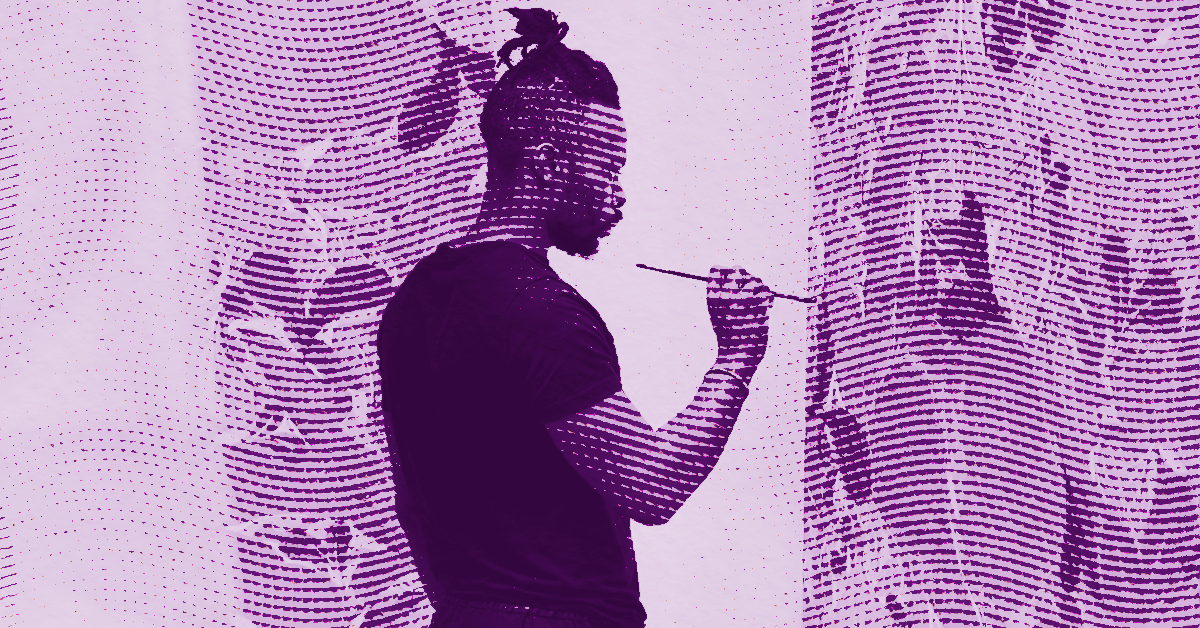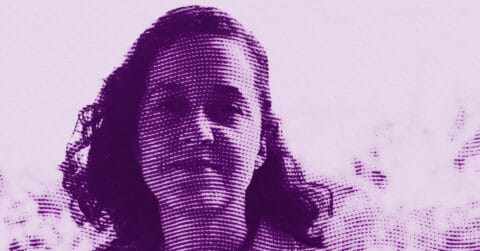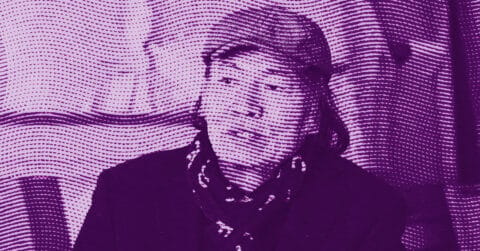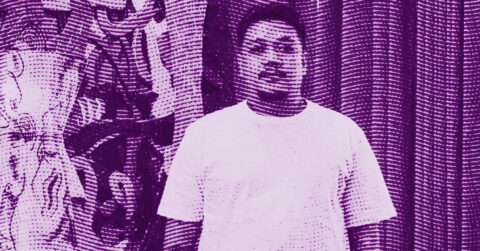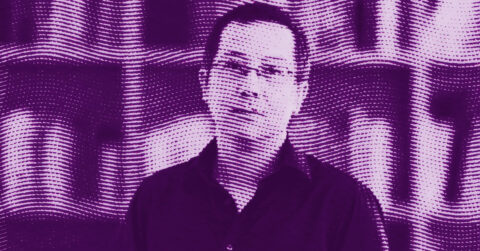Listen to me carefully, you bunch of snobs: Tunji Adeniyi-Jones paints as if every brushstroke were an act of resistance against collective amnesia. Born in London in 1992, trained at Oxford and then Yale, this British-Nigerian painter based in Brooklyn does not just color canvases. He rewrites the visual hierarchies that have trapped African art in the dusty showcases of primitivism for too long. His works are collision spaces where the Harlem Renaissance meets the bronzes of Benin, where Cubism dialogues with Yoruba ceremonies, where androgynous silhouettes dance between abstraction and figuration without asking anyone’s permission.
Adeniyi-Jones’s visual vocabulary is rooted in what he himself calls “cultural addition, combination, and collaboration.” This formula structures his entire approach. His characters emerge from abstract backgrounds saturated with stylized plant motifs. The sinuous bodies, rendered in flat areas of single color, fragment and dissolve into interlocking organic shapes. Reds, oranges, and yellows blend into compositions that evoke the patterns of Dutch wax fabrics, themselves products of complex intercultural exchanges. In some works, a dark palette of indigos and purples calls forth the night, the silhouettes drawn in light tones giving them a spectral appearance.
Double consciousness and the gaze that passes through the veil
This is where the thought of W.E.B. Du Bois becomes essential. In The Souls of Black Folk published in 1903, Du Bois introduced the concept of “double consciousness” to describe the unique experience of African Americans forced to see themselves simultaneously through their own eyes and through the racialized gaze of the dominant white society [1]. This duality, Du Bois defined as “this strange sensation of always looking at oneself through the eyes of another.” The philosopher described the feeling of “duplicity” experienced by Black Americans, torn between their American identity and their Black identity, two souls in conflict within one body.
Adeniyi-Jones visually enacts what Du Bois theorized philosophically. His figures with almond-shaped eyes, added last on each canvas, stare directly at the viewer. These gazes are never passive. The bodies he paints occupy space, hold it, move through it. We look at them, certainly, but they look back at us as well. For the artist, this exchange speaks precisely to Du Bois’s double consciousness: existing simultaneously in one’s own Black identity and in the alienating gaze of others. It is in this charged space, between autonomy and projected expectations, that Adeniyi-Jones celebrates the multifaceted nature of identity.
Recent works push this exploration even further. In his series “Immersions” presented in Seoul in 2025, the artist abandons traditional gravitational anchors. By rotating the canvas while working, he creates spaces without a determined horizon line. In some paintings, the body disappears completely, dissolved into the pictorial plane. The artist explains: “I am interested in representing the reverberation and the chromatic frequency that these bold characters leave behind them.” This dissolution is not annihilation but liberation. The figures escape the fixity of the alterizing gaze that Du Bois called “the veil.”
Du Bois’s double consciousness was not only a burden. It was also a gift, a “second sight” allowing one to see both sides of the racial veil. Adeniyi-Jones exploits this second sight by creating works that exist simultaneously within multiple visual traditions. His silhouettes evoke Aaron Douglas and the Harlem Renaissance while incorporating fluid lines inspired by Yoruba practices of body painting and scarification. His flat compositions refer to European cubism and Matisse’s cut-outs while grounding themselves in West African narratives. This multiplicity is a deliberate strategy to create, as the artist says, “a kind of different blackness,” a liminal space where the figure can exist as symbol, deity, mythical creature.
Du Bois stated that double consciousness created “two unreconciled desires, two ideals at war in a dark body.” Adeniyi-Jones rejects this irreconcilability. His works propose a synthesis, not by erasing tensions but by fully inhabiting them. The androgynous figures he paints embody this fluidity. By refusing to assign a fixed gender to his characters, the artist extends the logic of double consciousness beyond race. He suggests that all identities are multiple, fragmented, in motion. Fixity is violence imposed from outside.
Aaron Douglas and the silhouette as a strategy of multiplicity
Adeniyi-Jones explicitly cites Aaron Douglas as a major influence, particularly in his series of lithographs Midnight Voices created in 2022 [2]. Douglas, a central figure of the Harlem Renaissance, developed a characteristic style using elegant, rhythmic silhouettes to represent the African-American experience. His illustrations for Alain Locke’s The New Negro in 1925 established a visual language that fused European cubism, Art Deco, and the stylized forms of ancient African art.
Douglas used silhouette as an egalitarian device. By reducing his figures to dark profiles, he created universal images that anyone could read. This simplification carried considerable political weight. The silhouette refused physiognomic details that would have allowed reductive racialization. It offered what Douglas called an “expression of multiplicity.” A silhouette could be anyone. It resisted the visual stereotypes that saturated the racist imagery of the time.
Adeniyi-Jones understands this lesson and adapts it for the 21st century. In his lithographs, he reprises Douglas’s technique of black silhouettes on abstract backgrounds. But where Douglas mainly used black and white with accents of color, Adeniyi-Jones floods his canvases with violet blues, red-oranges, and bright fuchsias. This chromatic saturation firmly situates his works in the present while acknowledging their debt to the past.
Douglas created his works in a context of Jim Crow segregation, in a nation where the lynching of Black people remained a widespread practice. His silhouettes offered a visual dignity to African Americans at a time when their humanity was constantly denied. Adeniyi-Jones works in a different but no less charged context. After the Black Lives Matter movements, after decades of struggle for visibility in white artistic institutions, he creates works that refuse to be reduced to mere sociological documents. His paintings exist first and foremost as paintings, as formal explorations of color, composition, and space.
The reference to Douglas also allows Adeniyi-Jones to inscribe himself in a specifically Afro-Atlantic genealogy. By citing a Harlem Renaissance artist, he draws a line connecting London, where he was born, Lagos, where his Yoruba family comes from, Dakar where he resided, and New York, where he lives and works. This transatlantic circulation is not a dispersion but an accumulation. Each place adds a layer, an influence, a perspective.
Literary heritage and narrative resistance
Adeniyi-Jones explicitly situates his work in the wake of Nigerian postcolonial literature. He stated: “Every Greek myth or memorable fable we know has an equally powerful African equivalent, but because of reductive concepts like primitivism, the expansive world of ancient West Africa is rarely represented outside the continent. These cultural parallels have been detailed notably through the literature of Chinua Achebe, Wole Soyinka, and Amos Tutuola, and I want my paintings to serve as a visual accompaniment to this lineage” [3].
This reference to the giants of Nigerian literature is not accidental. Achebe published Things Fall Apart in 1958, a foundational novel that recounted the impact of British colonialism on the Igbo societies of Nigeria from an internal, African perspective. Before Achebe, British colonial literature represented Africans as savages without history or complex culture. Achebe methodically dismantled these stereotypes by showing the richness of precolonial social, religious, and philosophical structures.
Soyinka, the first African to receive the Nobel Prize in Literature in 1986, took this narrative decolonization even further. Playwright, poet, novelist, he created a body of work that fused Yoruba traditions with Western literary forms. Amos Tutuola published The Palm-Wine Drinkard in 1952, a phantasmagoric tale told in Nigerian pidgin, an English-based creole language, which mixed Yoruba folklore, fantasy storytelling, and literary modernism. His casual style and rejection of European literary conventions shocked some critics but deeply influenced an entire generation of African writers.
Adeniyi-Jones directly inherits this tradition of narrative resistance. His paintings visually accomplish what Achebe, Soyinka, and Tutuola achieved literarily: they assert the existence and legitimacy of African narratives that do not require Western validation to exist. When he represents singular objects such as an Asante royal stool, a West African performance mask, an Ife head, or a Benin bronze as starting points for his paintings, Adeniyi-Jones performs exactly the same gesture as Achebe telling Igbo ceremonies.
The artist also mentioned that his recent work largely consisted of “mourning paintings” created after the death of his father in November 2020. He explained: “All this work I did last year, these are mourning paintings. I make them to feel better, at the heart of absolutely everything” [4]. This brutal honesty about the therapeutic function of his art resonates with the Nigerian literary tradition that refuses to sugarcoat suffering but transforms it into aesthetic material.
The connection with Achebe, Soyinka, and Tutuola establishes that Adeniyi-Jones works within a tradition of intellectual resistance. These writers constructed a counter-narrative in response to colonial histories that had erased, distorted, or ridiculed African cultures. Adeniyi-Jones continues this project in the visual realm. His paintings demand space for African narratives in Western museums and galleries that have long excluded them.
It is significant that Adeniyi-Jones studied at Oxford and Yale, two historic bastions of white privilege. This education in colonial institutions gave him access to European artistic canons. But rather than being assimilated by these traditions, he cannibalized them, turning them against themselves. This strategy recalls that of Achebe, who wrote in English, the colonizer’s language, but twisted it to tell stories that dismantled the justifications of colonialism.
Hybridity as an aesthetic and political project
Adeniyi-Jones creates works that stubbornly refuse to be reduced to a single reading. By refusing to choose between his multiple influences, he creates pictorial spaces that are authentically hybrid. Not a homogeneous mixture where everything dissolves, but an assemblage where each element remains identifiable while transforming through contact with the others.
Adeniyi-Jones’s figures dance, dive, and spin through the space of the canvas. They are never still, never frozen. This perpetual kinetic energy embodies the diasporic experience itself, marked by displacement, migration, constant travel between multiple worlds. Adeniyi-Jones does not paint portraits of specific individuals. He paints the very experience of movement, transformation, becoming.
The almond-shaped eyes of his figures gaze at us. They remind us that we are observed as much as we observe. This reciprocity of gaze dismantles the traditional colonial dynamic where Black bodies were offered to the voyeuristic contemplation of the white gaze without ever being able to return that gaze. Here, the figures claim their subjectivity.
Adeniyi-Jones’s work arrives at a pivotal moment. After decades of struggle, Black artists are finally gaining significant visibility in Western art institutions. But this late recognition comes with its own pitfalls. The art market has an infinite capacity to absorb and neutralize critique. His paintings sell for six figures on the secondary market. How can one maintain a cultural resistance project when becoming a luxury commodity oneself?
The artist does not pretend to resolve this contradiction. But his works retain their subversive charge precisely because they refuse to be easily consumable. They require the viewer to do the work of understanding references, grasping connections, reflecting on implications. They resist, gently but firmly, lazy readings that would seek to reduce them to pretty exotic images.
The beauty of Adeniyi-Jones’s paintings is not a concession to decoration. It is a weapon. By creating visually seductive works, he draws the viewer in. Once captivated by the colors and shapes, the works begin to work on him in more subtle ways. Questions about identity, gaze, history, and power gradually insinuate themselves. Beauty functions as a Trojan horse for ideas that might otherwise be rejected.
Adeniyi-Jones belongs to a generation of Black artists who no longer accept the terms of the debate as established by white institutions. They do not ask for permission to exist. They create with a confidence that assumes their cultural references, histories, and concerns are central, not peripheral. This decolonial stance is not loudly proclaimed. It is embodied in every formal decision, in every chromatic choice, in every composition.
Adeniyi-Jones’s paintings are deeply contemporary while being anchored in millennia-old traditions. They look simultaneously towards the past and the future. This complex, non-linear temporality reflects African conceptions of time that have never been purely chronological. The past, present, and future coexist, interpenetrate, and mutually modify each other. Adeniyi-Jones paints this temporal coexistence by superimposing references to different eras, places, and traditions in a single pictorial space.
His works ultimately constitute a visual manifesto for what global art in the 21st century could be: not a universalism that erases differences under the pretext of unity, but a cosmopolitanism that celebrates multiplicity, insists that all traditions can dialogue on equal footing, and rejects hierarchies imposed by centuries of colonial domination. In Adeniyi-Jones’s canvases, Aaron Douglas dialogues with the Benin bronzes, Matisse with wax fabrics, jazz with Yoruba mythology. No one dominates.
It is this vision of a world where cultural addition replaces colonial subtraction that makes Adeniyi-Jones’s work essential today. At a time when national identities harden, borders close, and identity retrenchment gains ground, his paintings offer a generous alternative. They show that one can be faithful to one’s roots while opening up to other influences. That one can honor one’s heritage without fetishizing it. That one can create something new without betraying the past.
Adeniyi-Jones’s androgynous figures dance in impossible spaces, defying gravity, categories, and our expectations. They embody the freedom to become, to transform, and to refuse fixed identity assignments. In a world that constantly seeks to confine us in boxes, these fluid and elusive figures offer a liberating vision of what human identity could be freed from the constraints that stifle it.
Tunji Adeniyi-Jones does not claim to have all the answers. His paintings do not resolve the contradictions of the diasporic condition. But they create spaces where these tensions can coexist productively, where contradictions generate beauty rather than paralysis, where multiplicity becomes a strength rather than a weakness. That is why his work matters. Not because it offers easy solutions or comforting narratives. But because it shows us what the hard work of living fully in complexity looks like, of refusing reassuring simplifications, of embracing the creative uncertainty that comes when one accepts being many things at once. His canvases are spaces of freedom where Black bodies can exist outside imposed categories, where they can dance, dive, dissolve, and reappear on their own terms. It is a form of liberation painted in vibrant colors on canvases that refuse to stay quiet.
- W.E.B. Du Bois, The Souls of Black Folk, A.C. McClurg & Co., 1903.
- White Cube, “Tunji Adeniyi-Jones: Immersions”, exhibition press release in Seoul, January 2025.
- White Cube, artist biography of Tunji Adeniyi-Jones, whitecube.com, accessed October 2025.
- Brian Keith Jackson, “Tunji Adeniyi-Jones: the art of healing”, Art Basel Miami Beach 2021 magazine, 2021.

